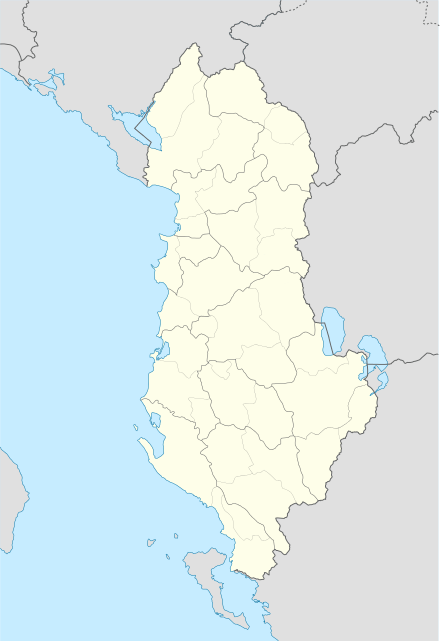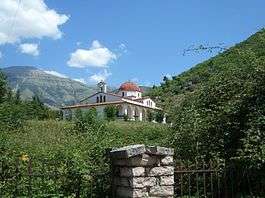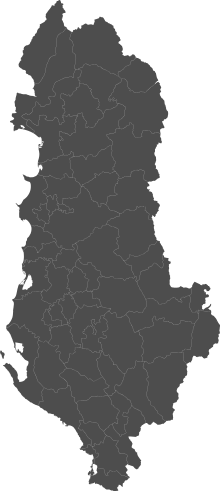Delvinë
Delvinë (Albanian: Delvinë or Delvina, Greek: Δέλβινο, Delvino) is a town and a municipality in Vlorë County, southern Albania, 16 kilometres (10 miles) northeast of Saranda. It was formed at the 2015 local government reform by the merger of the former municipalities Delvinë and Vergo, that became municipal units. The seat of the municipality is the town Delvinë.[1] The total population is 7,598 (2011 census),[2] in a total area of 183.01 square kilometres (70.66 square miles).[3] The population of the former municipality at the 2011 census was 5,754.[2]
Delvinë | |
|---|---|
 Emblem | |
 Delvinë | |
| Coordinates: 39°57′N 20°6′E | |
| Country | |
| County | Vlorë |
| Government | |
| • Mayor | Majlinda Qilimi (PS) |
| Area | |
| • Municipality | 183.01 km2 (70.66 sq mi) |
| Elevation | 207 m (679 ft) |
| Population (2011) | |
| • Municipality | 7,598 |
| • Municipality density | 42/km2 (110/sq mi) |
| • Municipal unit | 5,754 |
| Time zone | UTC+1 (CET) |
| • Summer (DST) | UTC+2 (CEST) |
| Postal Code | 9704 |
| Area Code | (0)815 |
| Vehicle registration | AL |
| Website | Official Website |
The town is built on a mountain slope. It has a mosque, a Catholic church, a Protestant church, and an Orthodox church. Nearby are the remainders of a medieval castle. To the south west of the city is the site of ancient Phoenice, which was declared an Archaeological Park in 2005.[4]
There is little local employment apart from that provided by the State, and Delvinë benefits little from the tourist boom in Saranda.
The town has a mixed population of Albanians and Greeks. According to the Human Rights Watch, Greeks constituted 50% of the town's population in 1989, but this fell to 25% in 1999.[5]
History
In antiquity the region was inhabited by the Greek tribe of the Chaonians. In the Middle Ages, Delvinë was part of the Despotate of Epirus. After defeat of Slavic tribes in 616 when they unsuccessfully besieged Thessaloniki, one of the tribes (Vajunites) migrated to Epirus. Until the 14th century this region in Epirus was referred to as Vanegetia, from the name of this Slavic tribe.[6] Similar toponyms like Viyanite or Viyantije survived until the 16th century when they were replaced with the name Delvinë.[7]
Delvinë under Ottoman Turkish control

The separate Sanjak of Delvina was established in the middle of 16th century,[8] due to the need to secure Ottoman control in the region towards potential Venetian infiltration from nearby Butrinto and to control the rebellious zone of Himara.[9] The county town was Delvinë, yet during the 18th century the local Pasha moved the seat of the sanjak from Delvinë to Gjirokastër. The official name did not change however, as it was also referred to as the Sanjak of Gjirokastër.[10]
In an ecclesiastical entry of 1635, the Codex of the church of Delvinë written in the Greek language noted that Muslims had increased and dwelt in quarters inhabited by Orthodox Christians, had confiscated their churches and converted them into mosques, thereby forcing the non-Islamized Christians to move to other quarters of the town.[11] The Turkish traveler Evliya Çelebi visited Delvinë around 1670 and gave some information about the city in his travel book. He reported that in the Middle Ages Delvinë was in the hands of the Spanish and later the Venetians.[12] In his own time, Ajaz Mehmet Pasha - a native Albanian - governed the Sanjak-bey of Delvinë.[13] The sanjak covered 24 zeamets and 155 timars.[13] There was a Turkish garrison, whose command on the castle was from Delvinë.[13] According to the description of Çelebi, the small fortress had a good cisterne, an ammunition depot and a small mosque.[13] In the city there were about 100 brick-built houses.[14] These stood relatively far apart and nearly every house had a tower.[14] He noted that a town wall was missing.[14] There was several mosques, three Medreses and about 80 stores, as well as an open market place.[15] Çelebi also observed that during this time, all the inhabitants of Delvinë spoke the Albanian language while having no knowledge of the Greek language.[16] In an ecclesiastical entry of 1730, the Codex of the church of Delvinë noted that some of the Christian Greek clergy had linguistic difficulties in administrating to their congregation, as there were Christian villagers living within the region of Delvinë who were Albanian speaking.[17] The local diaspora in Venice as part of the Venetian Greek community's Brotherhood of Saint Nicholas financially supported various initiatives for the expansion of Greek education in 18th century.[18] Thus, in two instances in 1713 and 1749, Spyros Stratis and Spyridon Rizos respectively, notable members of the local diaspora in Venice, financially supported the expansion of the local Greek education system, as well as donating vast sums of money to local Orthodox monasteries and churches.[18][19][20]
In 1878 a Greek rebellion broke out, with a unit of 700 revolutionaries, mostly Epirotes, taking control of Sarandë and Delvinë. However, it was suppressed by the Ottoman troops, who burned 20 villages of the region.[21]
In the early 20th century a çetë (armed band) consisting of 200 activists of the Albanian National Awakening was formed in Delvinë.[22] During the Balkan Wars and the subsequent Ottoman defeat, the Greek Army entered the city at March 3, 1913.[23] In June 1914 the town hosted the constituent assembly of the representatives of Northern Epirus that discussed and finally approved the Protocol of Corfu, on July 26, 1914.[24] Delvino then became part of the short-lived Autonomous Republic of Northern Epirus.
Jewish community
Until the Second World War, a small Jewish community existed in Delvinë. It consisted of Jews from Spain who had come to Delvinë when under Ottoman rule and had close connections to the large Jewish community in Ioannina. After the war, nearly all the Jews emigrated to Israel.
Education
The first school in Delvina, a Greek language school, was founded at 1537, when the town was still under Venetian control, and was maintained by bequests from wealthy local families.[25] Moreover, at 1875 a Greek female school was founded.[26]
Notable people
- Ecumenical Patriarch Serapheim II of Constantinople, cleric and Ecumenical Patriarch of Constantinople
- Themistoklis Bamichas, ethnic Greek politician and representative of Northern Epirus at the Paris Peace Conference of 1919
- Avni bej Delvina, bej of the city, was one of the signatories of the Albanian Declaration of Independence
- Sulejman Delvina, fifth Prime Minister of Albania
- Sabri Godo, writer and politician
- Limoz Dizdari, composer
- Laert Vasili, actor and director
References
- "Law nr. 115/2014" (PDF). Archived from the original (PDF) on 2015-09-24. Retrieved 2015-06-08.
- "Population and housing census - Vlorë 2011" (PDF). INSTAT. Retrieved 2019-09-25.
- "Correspondence table LAU – NUTS 2016, EU-28 and EFTA / available Candidate Countries" (XLS). Eurostat. Retrieved 2019-09-25.
- Finiq - Albanian Tourism - Official Website
- Nußberger Angelika, Wolfgang Stoppel (2001), Minderheitenschutz im östlichen Europa (Albanien) (PDF) (in German), p. 26: Universität KölnCS1 maint: location (link)
- Christie, Neil; Augenti, Andrea (2012). Vrbes Extinctae: Archaeologies of Abandoned Classical Towns. Ashgate Publishing, Ltd. p. 210. ISBN 978-0-7546-6562-5.
One can note that the Slav presence in the Butrint region probably endured: Butrint lies in the region known in the thirteenth century as Bagenetia or Vagenetia, but this term can be traced back to the Slavic tribe known as the Baiunetai.
- Hodges, Richard; Bowden, William; Lako, Kosta; R. D. Andrews (2004). Byzantine Butrint: Excavations and Surveys 1994-1999. Oxbow Books for the Butrint Foundation. p. 22. ISBN 978-1-84217-158-5.
The names Vagenetia, Viyanite and Viyantije survived until the Turkish period, ...
- Delvina, Sherif (2006). Low Albania (Epirus) and Cham issue. Eurorilindja.
Afterwards, when the Sanjak of Delvina has been created (about the middle of XVI century),
- Konstantinos., Giakoumis (2002). "The monasteries of Jorgucat and Vanishte in Dropull and of Spelaio in Lunxheri as monuments and institutions during the Ottoman period in Albania (16th-19th centuries)". University of Birmingham: 18. Retrieved 20 May 2018.
In order to combat Butrint, the last Venetian stronghold on Epirote soil, and to consolidate their control over the rebellious zone of Himarre, the Ottomans founded a separate sancak of Delvine
Cite journal requires|journal=(help) - Mikropoulos, Tassos A. (2008). Elevating and Safeguarding Culture Using Tools of the Information Society: Dusty traces of the Muslim culture. Earthlab. ISBN 978-960-233-187-3.
- Rathberger, Hrsg. von Oliver-Jens Schmitt. Red.: Andreas (2010). Religion und Kultur im albanischsprachigen Südosteuropa (1., Aufl. ed.). Frankfurt am Main: Lang. p. 85. ISBN 978-3-631-60295-9.
- Dankoff, Robert, & Robert Elsie (2000). Evliya Çelebi in Albania and Adjacent Regions: Kossovo, Montenegro, Ohrid. Brill. p. 59.
- Dankoff & Elsie. Evliya Çelebi in Albania and Adjacent Regions. 2000. p. 59.
- Dankoff & Elsie. Evliya Çelebi in Albania and Adjacent Regions. 2000. p. 61.
- Dankoff & Elsie. Evliya Çelebi in Albania and Adjacent Regions. 2000. p. 59, 61.
- Dankoff & Elsie. Evliya Çelebi in Albania and Adjacent Regions. 2000. p. 61. "The inhabitants all speak Albanian and do not know Greek."
- Xhufi, Pëllumb (2006). Dilemat e Arbërit[Arbëria's Dilemma]. Pegi. pp. 464-465. "Gjurmët e kësaj politike “informale” të realizuar nën hijen dhe nën mbrojtjen e Portës së Lartë, i gjejmë edhe një shënim të harruar të Kodikut të Delvinës të vitit 1730, i cili tregon se si peshkopi grek Genadhi e braktisi detyrën e bariut të të krishterëve të atyre trevave, “pasi nuk mund të duronte që banorët e tyre të flisnin gjuhën shqipe”. [Th. Bamichas, Kodiks tou naou tes poleos Delvinous, në: “Epeirotika Chronika” 5 (1930), f. 60 e vijim.]"
- Apostolidis-Kusserow, Karin (1983). "Nationalbewegungen auf dem Balkan". Die Griechische Nationalbewegung [The Greek National Movement] (in German). Otto Harrassowitz Verlag. 5: 79–80. ISBN 9783447022385. ISSN 0170-1533. Retrieved 20 June 2015.
In diesem Zusammenhang ware als nur ein Beispiel die "Griechische Bruderschaft St. Nikolaus... Delvino und Joannina finanziert... Der Kaufmann Spyridon Rizos... 200 Dukaten zur Verfugung.
- Koltsida, Athina Antonios (2007). Educational in Northern Epirus during the late Ottoman Empire: The founding, organization and operation of Greek schools. Aristotle University of Thessaloniki. p. 291. "Ο Δελβινιώτης ευεργέτης Σπύρος Στράτης συνέταξε το 1713 τη διαθήκη του στη Βενετία... χρηματοδότηση με αντίστοιχα ποσά σε εκκλησίες και σε μονές περιοχών του Δελβίνου, καθώς και στη μισθοδοσία εφημερίων."
- Cavaciocchi, a cura di Simonetta (2009). La famiglia nell'economia europea, secc. XIII-XVIII : atti della "quarantesima Settimana di studi," 6-10 Aprile 2008 = The economic role of the family in the European economy from the 13th to the 18th centuries. Firenze: Firenze University Press. p. 432. ISBN 9788884539106.
S. Rizos, from Delvino in Epirus (1749)... left money to 15 monasteries and churches in and around the place of his birth
- M. V. Sakellariou. Epirus, 4000 years of Greek history and civilization. Ekdotike Athenon. ISBN 978-960-213-371-2, p. 292.
- Skendi, Stavro (1967). The Albanian national awakening, 1878-1912. Princeton University Press. p. 421. Retrieved 24 April 2011.
- Veremis, John S. Koliopoulos & Thanos M. (2010). Modern Greece: a history since 1821 (1. publ. ed.). Malden, MA: Wiley-Blackwell. p. 73. ISBN 978-1-4051-8681-0.
- Kondis Basil. Greece and Albania, 1908-1914. Institute for Balkan Studies, 1976, p. 132: "Throughout the period of the constituent assembly which convoked at Delvino to discuss the Corfu agreement... the constituent assembly approved the agreement on July 26, 1914."
- M. V. Sakellariou. Epirus, 4000 years of Greek history and civilization. Ekdotike Athenon Archived 2010-06-14 at the Wayback Machine, 1997. ISBN 960-213-371-6. p 308: "Another important school was that at Delvino...very high standard".
- M. V. Sakellariou. Epirus, 4000 years of Greek history and civilization. Ekdotike Athenon, 1997. ISBN 978-960-213-371-2, p. 308
Further reading
- Themistoklis Bamichas (1930). "Codex of the Church of the city of Delvina". Ἠπειρωτικὰ Χρονικά, 5. pp. 56–75. (Greek)


